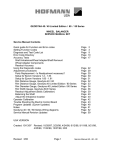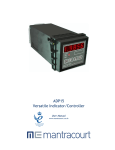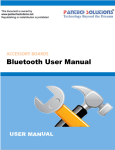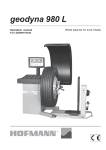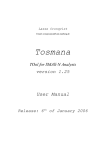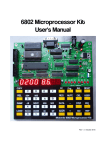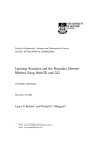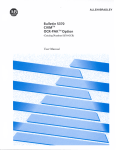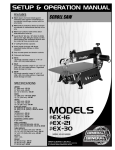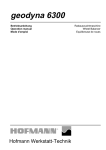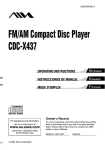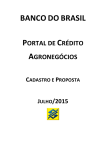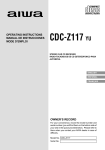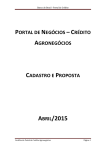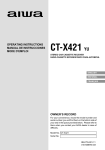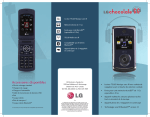Download Service Manual 39 Series
Transcript
GEODYNA 39 / 39 LM / 39 M WHEEL BALANCER SERVICE MANUAL SET Service Manual Contents Quick guide for Function and Error codes Setting Function Codes Diagnosis and Test Code List Error Code Directory Accuracy Tests Shaft Imbalance/Wheel Adapter/Shaft Remount Wheel Adapter Components Readout Accuracy Using the Diagnostic codes Adjustment procedures Parts Replacement - Is Readjustment necessary? Setup for Eprom Version 0.02 Setup for Eprom Version 1.10 & above Rim Distance Gauge Readout Adjustment (Basic Calibration) Geodyna 39 Readout Adjustment (Basic Calibration) Geodyna 39 M Readout Adjustment (Basic Calibration) Geodyna 39 LM Balancing the Shaft Adjust the Imbalance location Operator Calibration Trouble Shooting the Electric Control Board Program Updates (Eprom Updates) Notes: Geodyna 39 Series Wiring diagrams Service Manual Revision Updates Page 2 Page 3 Page 9 Page 10 Page 16 Page Page Page Page Page Page Page Page Page Page Page Page Page Page Page Page Page 21 27 27 28 30 31 32 33 34 35 35 37 38 42 44 45 49 USA VERSION Created: 10/13/97 Revised: 10/28/97, 2/25/98, 6/12/98, 9/11/98, 9/21/98, 4/25/99, 11/22/99, 12/07/99, 3/00 Revised 3/00 Page 1 Service Manual 39 Series Quick guide for Error and C-Functions Errors: Page: Functions: Page: E0 E1 E2 E5 E6 E7 E8 E9 E15 E30 E31 E34 E35 E36 E50 E51 E52 E53 E54 E55 E56 E58 E60 E61 E62 E63 E64 E65 E73 E74 E76 E77 E78 E79 E80 E136 10 10 10 10 10 10 11 11 11 11 11+41 12 12 12 13 13 13 13 13 13 13 13 13 13 13 13 14 14 14 14+41 15 15 15 15 15 15 C1C C2C C3C C4C C5C C8C C9C C10C C12C C13C C14C C15C C17C C20C C21C C24C C43C C46C C47C C53C C54C C55C C59C C60C C61C C62C C63C C64C C65C C66C C68C C69C C74C C75C C80C C83C C84C * * * * * * * * * * 03+28 03 03+28 03+09+19+35 04+28 04+28 04+28 03+04+36 04 04 08+36 04+09 04+28 05+08+28+35 05+09 05+29 06 28 07+28+30 09+21 09+21 09+21 09+22 09+22 09+23 09 09+24 09 09+24 09 09+24 09+24 09+25 09+26 08+31 08+32+34 08+35 Codes available starting in version number 0.02 1.10 0.02 0.02 0.02 0.02 0.02 0.02 0.02 0.02 0.02 1.21 0.02 0.02 1.21 0.02 0.02 0.02 Deleted after 1.10 0.02 0.02 0.02 0.02 0.02 0.02 0.02 0.02 0.02 0.02 0.02 0.02 0.02 0.02 0.02 0.02 0.02 0.02 0.02 *indicates the code can only be accessed by unplugging the Opto electronic cable from the Interface board. Revised 3/00 Page 2 Service Manual 39 Series SETTING FUNCTION CODES This list is for Eprom version 1.20 & later versions. For earlier versions see Program Updates. Function codes are verified, selected, and changed as follows: Enter a code by pressing C - the code number - then C again. The right display will show one of the numbers that follows the codes below. After verifying or changing the code press the RED (stop) button. Unless stored in the computer memory (located on the Interface circuit board) a function code that has been changed returns to the original state when the power is turned off. To store code settings in the computer memory: Enter C 1 0 C. Then press keys 1 & 3 at the same time. The Processor circuit board issues three tones signaling the code setting has been stored in the memory. ✽ The following codes can only be accessed by unplugging the Opto electronic cable from the Interface board: C1, C2, C8, C9, C17, C20, C21, C24, C43, C47 If the codes are entered without having the Opto electronic unplugged a E0 will appear. C1: ✽ Readout resolution (round-off) - Press the ● (decimal) button to change. Car 1 = 0.05 Ounce / 1 Gram Truck 1 = 0.50 Ounce / 10.0 Gram 0 = 0.25 Ounce / 5 Gram 0 = 1.00 Ounce / 50.0 Gram Factory set to 0 C2: ✽ Readout suppression of small imbalances, as selected using C9 or C8. Press the ● button to turn on or off. 1 = On Factory set to 1 0 = Off If the readout is set to read in ounces, the suppression value used is from C9. If the readout is set to read in grams, the suppression value used is from C8. C3: Readout in ounces or grams - Press the ● button to change. 1 = Ounces Factory set to 1 0 = Grams C4: Electronic compensation of the residual imbalance. Enter C 4 C then press the Start button to go through a cycle. Press the stop button to continue. Compensation cannot be stored in the computer memory and retained when power is off. It resets to 0 whenever power is turned off. 1 = On 0 = Off Revised 3/00 Page 3 Service Manual 39 Series SETTING FUNCTION CODES (Cont.) C5: Machine brakes or coasts when the wheel guard is lifted. Press the ● button to change. 1 = Brakes Factory set to 0 0 = Coasts C8: ✽ Selection and entry in grams of the readout suppression of small imbalances. Factory set to 5.0 grams (Car) \ 50.0 grams (Truck). All imbalances of the selected weight or less will display 0 grams. To enter a new value enter C8C, key in the new value, press the C button. C9: ✽ Selection and entry in ounces of the readout suppression of small imbalances. Factory set to 0.25 ounce (Car) \ 2.0 ounces (Truck). All imbalances of the selected weight or less will display 0.00 ounces. To enter a new value enter C9C, key in the new value, press the C button. C10: Stores selected codes data and adjustments into the computer memory located on the Interface circuit board. Enter C 10 C then press buttons 1 & 3 at the same time. Listen for a 3 tone beep. C12: Total balancing cycles. Entry of this code displays the total number of measuring runs the balancer has operated. The maximum count is 999,999. See Code C43C to reset the counter. C13: Selects operation by start button or wheel guard. Press the ● button to change. 1 = Machine starts as the wheel guard is closed or when the start button is pressed. 0 = Machine starts only when the start button is pushed. C15: Led Light Show. Press the ● button to change. 0 = disabled 1 = enabled after 5 minutes of non-use 2 = test (always on) C17: ✽ With this function you can select 5 through 10 revolutions for a measuring run. Factory set to 10 revolutions. If the PRO-MATCH program is in use, the measuring revolutions are automatically set to 10. NOT RECOMMENDED TO USE THIS CODE. Press the ● button to change. Revised 3/00 Page 4 Service Manual 39 Series SETTING FUNCTION CODES (Cont.) C20: ✽ Adjusts location imbalance. The default value is 50 for the 39 / 39 M & 140 for the 39 LM. Mount and balance a wheel to within 1 ounce. Then Enter C 4 C. A 0 will show in the right display, C4 in the left. Press the START button. The balancer will run through cycle, stop and display a 1 in the right display. Press the STOP button. Attach a weight to the outside of the wheel. Press the START button. After the wheel stops rotate it until only the center bar is on in the right hand display, weight should be at 6:00. If the weight is not at 6:00 then it will need to be adjusted. To Adjust: The Geo 39 \ 39 M loosen the screws that hold the weight tray, and then lift the front of the tray up slightly. The Geo 39 LM remove display panel. Unplug the Opto electronic cable from the Interface board. Enter C 20 C. Reconnect the Opto electronic cable. A number will appear in the right hand display. If the weight is before 6:00 enter a number higher than the displayed (default) number, press the C button. If the weight is after 6:00 then enter a number lower than the displayed (default) number, press the C button. Press the START button and check to see if the location is correct, if not perform adjustment again. After location is adjusted properly then store it in the permanent memory with code C10C. C21: ✽ Selects the amount of braking time. Mainly used for the 39LM. It is selectable from 0 to 9. Press the ● button to change. C24: ✽ Selects rim distance must be entered in millimeters (mm) or centimeters (cm) through the key panel. The machine is factory set for cm. To check for the correct setting: Enter code C 2 4 C 1 = display entry must be made in cm - This is the correct setting 0 = display entry must be made in mm - This is the incorrect setting If 0 displays press the ● key to change to 1. Press the stop button. Revised 3/00 Page 5 Service Manual 39 Series SETTING FUNCTION CODES (Cont.) C43: ✽ Resets the cycle counter. Built into the software of the balancer is a counter that records each time the balancer is operated. When code C12C is entered the total of measuring runs is displayed. To reset the counter to zero: Unplug the balancer from line voltage. The Geo 39 \ 39 M. Loosen the screws that hold the weight tray, and then lift the front of the tray up slightly. The Geo 39 LM remove display panel. Unplug the Opto electronic cable from the Interface board. Enter C 4 3 C. Unplug the balancer from line voltage. Reconnect the Opto electronic cable and reassemble machine. Revised 3/00 Page 6 Service Manual 39 Series SETTING FUNCTION CODES (Cont.) C47: ✽ Sets the computer to operate in a specific balancer mode. For version 1.10 and above the display will show: GEO 39, or GEO 39.L, or GEO 39.o, or GEO 40.S Press the ● key to change. GEO 39 GEO 39.L GEO 39.o Geodyna 39 Passenger balancer Geodyna 39 LM Truck balancer Geodyna 39 M Motorcycle balancer Note: For previous Eprom program versions refer to Program Updates When C47C is accessed or changed the following codes are automatically set to the default values below. For Eprom Versions 1.20 and above for previous versions see program updates. Eprom version 0.02 each code has to be set manually. FOR 39/39.o FOR 39.L C1 = 0 C1 = 0 C2 = 1 C3 = 1 C5 = 0 C2 = 1 C3 = 1 C5 = 0 C8 = 5.0 C9 = 0.25 C13 = 0 C8 = 50.0 C9 = 2.0 C13 = 0 *C15 = 1 C17 = 10 C20 = 50 (46)* *C21 = 3 C24 = 1 C80 = 170 *C15 = 1 C17 = 10 C20 = 140 *C21 = 3 C24 = 1 C80 = 285 Readout Resolution Car 0.25 oz \ 5 gr Truck 1.00 oz \ 50 gr Suppression on Displays ounces Brakes w/wheel guard(for possible future use) Suppression value in grams Suppression value in ounces Disable wheel guard start (for possible future use) LED light show on Number of revolutions for measurement Angle correction Brake cycle time Distance entry in cm Adapter flange distance in mm * For Eprom version 1.21 Revised 3/00 Page 7 Service Manual 39 Series SETTING FUNCTION CODES (Cont.) ADJUSTMENT CODE LIST C14 Operator Calibration C20 Imbalance location adjustment or angle correction C80 Adjustment of rim distance gauge C83 Basic adjustment of the imbalance readout C84 Shaft imbalance correction Revised 3/00 Page 8 Service Manual 39 Series DIAGNOSIS AND TEST CODE LIST C4 Imbalance compensation C15 LED Light show C21 Braking time C53 Display test C54 Opto electronic test C55 Unregulated D.C. voltage at Processor circuit board C59 Value of the shaft imbalance compensation stored in the Memory C60 Shaft RPM C61 Reference imbalance Value determined during last C83 adjustment C62 Imbalance location displayed in degrees C63 Continuous high resolution imbalance measurement averaged and displayed each 40 revolutions. C64 Pick-up sensitivity C65 Pick-up phase difference in percent C66 Virtual vibratory system dimensions determined during last C83 adjustment C68 Number of revolutions required to reach measuring speed C69 Automatic testing measurement cycle intervals C74 Position disc. Opto electronic test. Also see C54. C75 Pick-up test / Opto electronic test. Revised 3/00 Page 9 Service Manual 39 Series ERROR CODE DIRECTORY Many of the error codes are followed by the most probable cause of the error & / or action to be taken. This action assumes proper electrical/electronic wiring connections. E0 Keyboard entry of a non-existent error code. E1 display with Rim distance setting is impractical for balancing using the selected ALU 2 or 3 mode. The distance between the rim center flange and left correction plane is too narrow. E1 with display Rim width entered is out of range. E1 display with Rim diameter entered is out of range. E2 Check jumper at terminals 1 & 2 on the interface board. E5: Wheel is too far out of balance for zero balance compensation during function code C4, or calibration weight was inserted by mistake during CAL 1. E6: Calibration weight was not inserted during Cal 2 step of the user calibration - or both pick-ups are disconnected. E7: ALU mode was selected after rim dimensions have been entered in mm. Dimensions must be entered in inches (width & diameter) to use the ALU modes. → ↔ ↕ Revised 3/00 Page 10 Service Manual 39 Series ERROR CODE DIRECTORY (Cont.) E8: During tire matching the valve position was not entered. E9: Tire matching error: • An error was made following the procedure. or • The wheel was incorrectly centered on the adapter. or • The tire was incorrectly mounted on the rim. E15: During operator calibration: ( C14C ) The correction factors used for calibration are incorrect Causes: 1. The Geodyna 39 Series uses a wheel adapter that is different than many earlier model Hofmann balancers. The machines use a longer threaded center sleeve. The backing plate (the surface the wheel presses against) is extended about 3/4" from previous versions. Both types of wheel adapters can be used but it is necessary to set the Distance Gauge Adjustment to match the adapter used. See Adjustment, Distance Gauge. Follow instructions using code C 80 C. The value determined must be stored in the memory, see Store Adjustments in Memory. 2. The Pick-up output voltage has changed. Check and replace pickups if necessary. 3. There may be a wheel weight lodged in or along side the vibratory structure. E30: The shaft did not reach measuring speed within 50 revolutions. Check the drive motor, Opto electronic using codes C54 & C74. E31: The balancer shaft attempted to turn in the wrong direction. Check the drive motor connections, and start capacitor. Revised 3/00 Page 11 Service Manual 39 Series ERROR CODE DIRECTORY (Cont.) E34: Phase difference between Pick-ups is more than 3°. See codes C61, C65 & C75. 1) Check the Pick-up connections at the Interface circuit board. Are they connected to the correct terminals? 2) Check that the Pick-ups are tightly mounted under the shaft in the Vibratory assembly. 3) Check that the four vibratory assembly mounting bolts are tight. 4) Replace the Pick-ups one at a time. Note: The display is the phase difference found during the last C83 adjustment. In order to display another value it is necessary run C83 again after replacing each Pick-up. E35: Left Pick-up output voltage does not correspond to rim width or distance settings during code C83 adjustment. See E36 for troubleshooting. E36: Right Pick-up output voltage does not correspond to rim width or distance settings during code C83 adjustment. To trouble shoot: 1) 2) 3) 4) 5) 6) 7) 8) 9) See code C61C Check that the actual rim width (use Hofmann calipers), and distance has been set. Has the C80 procedure (rim distance adjustment) been properly followed? Check that the machine is sitting solidly on the floor and only resting on the three mounting pads. Tilt the machine back to check underneath for wheel weights, etc. If the machine is bolted to the floor make sure either all bolts are tight or all are loose to eliminate the possibility that one mounting pad is not solidly touching the floor. It is best to loosen all three mounting bolts and tilt the machine back to check for anything under the machine. Check for a wheel weight lodged in or along side the vibratory structure. Check the Pick-up connections at the Interface circuit board. If E36 is displayed with E34 it's likely the problem is a defective pick-up. Check that the Pick-ups are tightly mounted under the shaft in the vibratory system. They should not turn by hand. Check that the four vibratory system mounting bolts are tight. Try C83 Readout adjustment again using another wheel and tire assembly or only a wheel. If C83 adjustment was attempted using a thick alloy wheel try adjustments again using a steel wheel. Revised 3/00 Page 12 Service Manual 39 Series ERROR CODE DIRECTORY (Cont.) E50: Eprom defective. The Eproms are mounted on the Processor circuit board sockets ROM 1 and ROM 2 and are field replaceable. When this error code appears both Eproms should be replaced. E51: Ram defective. The Ram is not field replaceable - replace the Processor circuit Board. E52: Left A/D Converter defective. The A/D converter is not field replaceable replace the Processor circuit Board. E53: Right A/D Converter defective. The A/D converter is not field replaceable replace the Processor circuit Board. E54: Power supply to the machine measured at the Processor circuit board is low. See Error Diagnosis section C55. E55: Power supply to the machine measured at the Processor circuit board is high. See Error Diagnosis section C55. E56: A/D reference voltage incorrect. Replace the Processor circuit board. E58: Processor circuit board error, PIO. Replace the Processor circuit board. E60: Display error. One of the seven segment displays or LED's is defective. Replace the Display circuit board. E61: Start, stop or keyboard key is stuck closed. Can be the Display circuit board or the Processor circuit board defective. If replacement of either board is necessary connect a wire from the panel ground to the machine chassis ground. Use a panel circuit board hold down stud. E62: Memory defective. Replace the Processor or Interface circuit board. If a replacement board is not at hand adjust the machine following adjustment procedures, then leave the power on until the defective part can be replaced. E63: Adjustment &/or function code data memory on Interface circuit board is incorrect. When the power is switched on the computer program transfers stored data from the Interface circuit board data memory to the Processor circuit board memory. If an error is detected code E63 displays. It is possible this error can occur because of loss of stored data caused by large voltage variations in the balancer power source. This could occur during lightning storms or by power distribution problems. Readjust and set function codes. If E63 reoccurs replace the Interface circuit board. Revised 3/00 Page 13 Service Manual 39 Series ERROR CODE DIRECTORY (Cont.) E64: 24 vdc is not available on the Interface circuit board. Check the 0.8 amp fuse on the Interface circuit board. If the fuse continues to blow there can be short at one of the contactor coils. Disconnect one at a time to trouble-shoot. The problem may also be the Interface or Processor circuit board. E65: Power supply voltage to the Processor circuit board dropped too low during the balancing cycle to ensure accurate readings. Measure the line voltage, connections to the balancer and the internal connections. See code C55. E73: Transmitter (IR LED) of Opto electronic defective. Test using codes C54 & C74 & C75. Opto electronic, Processor board may be defective. E74: No pulses are measured from the Opto electronic. The Processor circuit Board does not recognize that the balancer shaft is turning. Does the shaft turn? If yes, test using codes C54 & C74. Opto electronic or Processor circuit board may be defective. If not, the error code is not caused by the Opto electronic. Check the power to the machine, internal electrical system, motor relay, fuses and connections. If the motor can be heard turning but the balancer shaft does not, check the drive belt and tension assembly. If the motor hums only and E74 comes on after a few seconds, it may be a defective start capacitor. Revised 3/00 Page 14 Service Manual 39 Series ERROR CODE DIRECTORY (Cont.) E76: Left Pick-up reference voltage incorrect. To trouble-shoot see E77. E77: Right Pick-up reference voltage incorrect. To trouble-shoot: 1. Switch the power off. Unplug both Pick-ups from the Interface circuit board. Switch the power on. If E76/77 still displays replace the Interface circuit board. If not, go to 2. 2. Switch the power off. Plug the left Pick-up into the right terminal and the right Pick-up into the left. Switch the power on. If the error code follows the Pick-up, replace the Pick-up. If not replace the Interface circuit board. Symptom: After turning on power E76 and/or E77 appears. These error codes indicate a wrong D.C. voltage on the left and/or right transducer (Pick-up). These voltages can be observed using code C75C then press #5. The proper voltage should be 2.50 +/- 0.05 volts. Cause: These error codes can be caused by a defective interface board or a build up of film on the board. The latter fault will become evident in very humid conditions. E78: Incorrect output is measured from the left Pick-up. See code C75. Left Pick-up, Processor or Interface circuit board may be defective. E79: Incorrect output is measured from the right Pick-up. See code C75. Right Pickup, Processor or Interface circuit board may be defective. E80: Basic calibration data was not found in the memory. Can be that steps 5 and 6 were not stored in the memory during basic adjustment (C83). Reset the Function codes and then follow the adjustment procedures, C83 & C84. If error code E80 repeats replace the Interface circuit board. E136: Computer data line defect. Check ribbon cable to Processor board (loose plug). Replace the Processor or Interface Circuit board. Revised 3/00 Page 15 Service Manual 39 Series ACCURACY TESTS PASSENGER & LIGHT TRUCK WHEELS ONLY SHAFT IMBALANCE, WHEEL ADAPTER TO SHAFT REMOUNT TEST 1. Make sure electronic compensation is off. Check by entering code C4, 0 must be displayed. If 1 appears switch the balancer off and then back on after a few seconds. 2. Set the corresponding rim dimensions and balance a medium size 14" tire to 0.00 ounce in both planes. Balance to exactly 0.00 in both planes with the small imbalance suppression (C2) turned off. 4 Operate the balancer a few times and insure that no more than 0.05 oz. is displayed. 5. Using the supplied 14 mm Allen wrench loosen the Allen bolt located in the center of the threaded sleeve. 6. Rotate the wheel adapter with the balanced tire 180° on the balancer shaft then tighten the Allen bolt. 7. Operate the balancer. The new imbalance displays should not be larger than 0.25 oz. This test proves the wheel balancer shaft is balanced, turns true and that the wheel mounting adapter and balancer conical shaft mating surfaces are true. If the test produces readings out of tolerance: 1. Remove the complete wheel adapter and operate the balancer. The display should indicate zero. If not balance the shaft following Code C84 - see Adjustment Procedures. 2. Remove the wheel adapter and check the mating surfaces of the wheel adapter and balancer shaft. They should be clean and smooth. After cleaning if a further test still produces unacceptable results: A: Run the above test using a known good wheel adapter. If another test produce the same results go to B. If not, replace the threaded sleeve portion of the wheel adapter. B: Using a dial indicator, measure the run-out at the balancer shaft conical surface. The acceptable tolerance is 0.0015". If out of tolerance replace the balancer shaft. Revised 3/00 Page 16 Service Manual 39 Series ACCURACY TESTS (Cont.) WHEEL ADAPTER COMPONENTS - CENTER CONE ADAPTER REMOUNT TEST. Important note: Please read first The test will check the wheel as well as the wheel adapter. Most wheels are manufactured to less exact tolerances than the wheel adapter. The majority of the measured remount error is usually caused by the wheel - not the wheel adapter. It is best to use a wheel that is known to be true. The wheel must have a round smooth center hole and the surface that presses against the wheel adapter backing plate must be flat and smooth. Because remount error is a function of mechanical tolerances the heavier the wheel assembly the larger the mounting error. Use a mid size 14" or 15” wheel and tire - about 30 to 40 pounds. Usually OEM alloy wheels will remount best. 1. First, make sure the results of the SHAFT IMBALANCE, WHEEL ADAPTER TO SHAFT REMOUNT TEST are acceptable. 2. Electronic imbalance compensation must be off. Check, by entering code C4. 0 must be displayed. If 1 appears switch the balancer off and then back on after a few seconds. 3. Balance a 30 to 40 lb. wheel, exactly to 0.00 in each plane with the small imbalance suppression (C2) turned off. 4. Operate the balancer a few times and insure that no more than 0.05 oz is displayed. 5. Loosen the wing nut, hold the centering cone in place and rotate wheel 180 degree. Tighten the wing nut. 6. Operate the balancer through a cycle. The new display is the remount error. A reading not larger than 0.50 ounce is generally acceptable. If the readings are not acceptable: 1. Are you using a wheel known to be true? See Important Note above. Try the test using another wheel. 2. Are the mating surfaces of the wheel adapter backing plate and the threaded sleeve clean and smooth? 3. Is there a large amount of play between the center cone and threaded sleeve? Check against another cone in the set. Run the same test but this time only rotate the cone 180 degree. Revised 3/00 Page 17 Service Manual 39 Series ACCURACY TESTS (Cont.) 4. Using a dial indicator measure the radial run out of the threaded sleeve at the point where the threads end. The acceptable tolerance is 0.0015". 5. Using a dial indicator measure the lateral run out of the wheel adapter face plate as the shaft is rotated 360 degree. The acceptable tolerance is 0.0015". 6. Use known good wheel adapter components individually to localize the cause of the unacceptable remounting error. Revised 3/00 Page 18 Service Manual 39 Series ACCURACY TESTS (Cont.) C4 - Use this code to check the balancer imbalance read-out accuracy to insure that the proper size and location of the correction weight is called for. To use: 1. Mount a wheel, enter rim sizes, and then balance the wheel to within 1 ounce on each side. Enter C 4 C. A 0 will show in the right display, C4 in the left. Press START (green) button. 2. The balancer will run through a cycle, stop and display a 1 in the right display. The 1 displayed means that the out of balance wheel has been measured by the computer. The measured imbalance will be subtracted from the next measurement runs. The test wheel imbalance will remain stored in the computer memory until the machine is switched off or until C4 is again selected and the 1 is changed to a 0 by pressing the ● button. 3. Press and hold the STOP (red) button. The right and left display will each show 0.00. Release the STOP button. 4. Select a hammer on type wheel weight of about 3 ounces for this test. It is important that you are sure that the actual weight agrees with what is marked on the weight. Be sure that the weight has not been clipped. 5. Attach the weight to the right side of the wheel, then operate the balancer. 6. When the balancer stops press and hold in the STOP (red) button. A weight reading corresponding to the test weight is shown in the right display. The allowable tolerance is +/- 0.15 ounce. 7. A weight reading is also shown in the left display. The maximum allowable reading is 0.15 ounce. If it's out of tolerance see (A) on next page. Release the STOP (red) button. Example: If a 3 ounce test weight was selected. It is acceptable if the display shows between 2.85 and 3.15 for test weight side and no more than 0.15 for the opposite side. Revised 3/00 Page 19 Service Manual 39 Series ACCURACY TEST (Cont.) 8. Position the test weight at exactly 6 o'clock. The center bar of the right location display should be on. The allowable tolerance is +/- one bar from center. If it's out of tolerance see (B). Remove the test weight from the right side of the wheel and attach it to the left side, then operate the machine. 9. When the machine stops press and hold in the STOP (red) button. The allowable tolerance is 0.15 ounce as shown in the example above. Release the STOP (red) button. (A) - First check the rim distance gauge setting following code C80C. Then follow the ADJUSTMENT PROCEDURES. (B) - If the imbalance read-out accuracy was found out of tolerance follow as per (A). If only the location accuracy was found to be out of tolerance, then adjust the location using the code C20C. If it is properly adjusted then the wheel has probably slipped on the balancer shaft while braking it. There is also a slight possibility that there is a problem with a pick-up or Opto electronic. If these two components are suspected substitution with known good parts is the only method of trouble-shooting. TO END THE TEST PRESS C 4 C, THE ● KEY, & THE STOP BUTTON. Revised 3/00 Page 20 Service Manual 39 Series USING THE DIAGNOSTIC CODES To use the codes enter C code # then C. C53 - Use this code to check the display circuit board. Enter C53C All LED segments will light. If one or more segments are defective, error message E60 would have displayed when the machine was switched on. To correct for a missing segment, it is recommended to replace the display circuit board. *************TO END THE TEST PRESS THE STOP BUTTON************* C54 - Use this code to check the Opto electronic. The complete test consists of four sections and is done with the motor turning the shaft. Also see test code C74. ■ ■ ■ ■ Enter C 5 4 C - Press start. This is the A channel test. 1 will show in the left display. The right display will show a number which may fluctuate +/- two numbers. This number should be within the range of 40 - 60. Press the ● button. 2 will show in the left display. This is the B channel test. The right display will show a number, which may fluctuate +/- two numbers. This number should be within the range of 40 - 60. Press the ● button. 3 will show in the left display. This is the zero reference test. The right display will show a number, which may fluctuate +/- two numbers. This number should be within the range of 40 - 60. Press the ● button. 4 will show in the left display. The right display will show a number, which may fluctuate +/- two numbers. This number should be within the range of 20 -35. You may monitor each test repeatedly by pressing the ● key. If any of these tests display readings which are not within the specified range the Opto electronic may need replacing. It is only recommended to replace the Opto electronic if an out of tolerance reading is found along with a machine malfunction. It is not recommended to replace the Opto electronic if the above tests indicated a reading slightly out of tolerance. *************TO END THE TEST PRESS THE STOP BUTTON************* Revised 3/00 Page 21 Service Manual 39 Series USING THE DIAGNOSTIC CODES (Cont.) C55 - Use this code to check for proper D.C. voltage at the Circuit Board. A function of the Processor circuit board is to provide a DC power supply. Depending on operating voltage either 115 or 230 volts AC is supplied to the transformer primary. The transformer reduces the voltage at the secondary to approx. 18 27 volts AC. The secondary voltage is converted by the power supply portion of the processor circuit board to DC voltage, filtered and regulated. The DC voltage is used to operate the electronic circuits and motor control relays. Enter C 55 C - The right display indicates the DC voltage. The allowable working voltage is 16 to 37 VDC for Eprom version 1.21 & 23 - 37 for Eprom versions 0.02 - 1.20 If error E54 was displayed when the machine was turned on, less than the allowable voltage will be measured. If error E55 was displayed when the machine was turned on, more than 37 VDC will be measured - SWITCH THE POWER OFF! Disconnect the Processor circuit board 34 pin connector for further troubleshooting. To trouble-shoot check the voltage at the wall receptacle, the input voltage to the balancer at the transformer primary, and the output voltage from the secondary. *************TO END THE TEST PRESS THE STOP BUTTON************* C59 - Use this code to display the shaft imbalance compensation value stored in the memory. The value is determined during the Shaft Balance procedure (C84). Enter C 5 9 C. The displayed value is the shaft compensation in kg mm. *************TO END THE TEST PRESS THE STOP BUTTON************* C60 - Use this code to measure the speed of the balancing shaft. The Processor circuit board counts pulses received from the Opto electronic. These pulses are the result of a slotted disc read by the Opto electronic as the shaft turns. The pulses are routed through the Interface circuit board. Enter C 6 0 C. Press start. The RPM is displayed. Balancing speed is 90 – 110 RPM (nominal). *************TO END THE TEST PRESS THE STOP BUTTON************* Revised 3/00 Page 22 Service Manual 39 Series USING THE DIAGNOSTIC CODES (Cont.) C61 - Use this code to check for changes in the Pick-up outputs. Each time the balancer readouts are adjusted using the service code C83C a reference value of 1.0000 is stored in the memory for the left and right Pick-ups separately. Whenever the readouts are adjusted using operator calibration code C14C each value of 1.0000 will change to a higher or lower value. The new value reflects the compensation made by the processor circuit board depending on the condition of the each individual pick-up output as measured at the processor circuit board. Slight variations are acceptable and are the result of aging and temperature or changes in the circuit component path. Large variations may not be acceptable and can yield error codes or balance problems. The Pick-up outputs and the circuit component path determine readout, location accuracy and imbalance readout separation between correction planes. To monitor the reference outputs: Enter C61C. The left location LED’s will light and the display will show the left Pick-up reference voltage. Pressing the decimal key will light the right location LED’s and the right pick-up reference voltage displays. Pressing the decimal key will toggle between the left and right reference voltage. The code can be helpful for troubleshooting a machine that may continually require readjustment via user calibration code C14C or a machine that develops a measurement related error code or “chases weights”✸ during operation. Example: The customer complains that the machine usually does not balance a wheel to zero in one or two spins. The operator is “chasing weights” ✸ around the rim. After running the machine through C14C the technician using code C61C finds that the value for the right Pick-up is 1.0030 (little change from the reference of 1.0000), but the value for the left pick-up is .9000 (a larger change). This indicates the likely cause of the problem is a faulty or loose left pick-up ✸. When troubleshooting be aware that the reference voltage is measured by the processor circuit board and not directly read at the Pick-up. This means that the large difference in output can have a cause other than the pickup. Be aware that in series with the Pick-up output path to the processor is the interface circuit board. ✸ Tip: Revised 3/00 Whenever a machine is “out of calibration,” “chases weights” or will not go through C14C or C83C procedures without an error code always check for anything touching the internal balancing structure. It is always necessary to remove the weight tray and check carefully for foreign material such as a stray wheel weight. It is also necessary to check under the wheel balancer making sure only the three intended points touch the floor. Page 23 Service Manual 39 Series USING THE DIAGNOSTIC CODES (Cont.) C63 - Use this code to set the machine into the continuous display mode. As the shaft turns the display will blink each 40 revolutions as updated imbalance inputs are averaged. This code is helpful while trouble shooting for a intermittent or erratic read-out. Enter C 6 3 C. Press start. *************TO END THE TEST PRESS THE STOP BUTTON************* C65 - Use this code to check the phase difference between the two Pick-ups. For the computer to correctly calculate the imbalance correction weight needed it is necessary that the output voltages from the Pick-ups are in phase. Error message E34 will display during a Code C83 adjustment if the Pick-ups are detected to be out of phase by more than 3 degrees Enter C 6 5 C - The phase difference will display. *************TO END THE TEST PRESS THE STOP BUTTON************* C68 - Use this code to check the operation of the electrical system. Enter C 6 8 C. The left display shows the number of shaft revolutions required to reach measurement speed during the last measurement. The right display shows the number of shaft revolutions required to reach the speed where the motor start capacitor switching relay dropped out during the last measurement cycle. *************TO END THE TEST PRESS THE STOP BUTTON************* C69 - Use this code to set up the automatic measurement cycle. This cycle can be used to allow an unattended machine to measure, brake to a stop, sit at rest, then measure, brake to a stop continuously. The rest intervals can be selected. This code is helpful while troubleshooting any intermittent problem, especially in an equipment repair shop environment. Enter C 6 9 C. The left display will show 1. This is rest interval one. The right display will show 50.This is the preset rest interval in seconds. To change the interval key in a new interval in seconds, then press the C key. The left display will show 2. This is preset rest interval two. The right display will show 170. To change the interval key in a new interval in seconds. Press the start button. The machine will cycle continuously. *************TO END THE TEST PRESS THE STOP BUTTON************* Revised 3/00 Page 24 Service Manual 39 Series USING THE DIAGNOSTIC CODES (Cont.) C74 - Use this code as a quick check of the Opto electronic without the shaft turning under power. For the complete Opto electronic test use code C54. Enter C 7 4 C. The left display will show C74. The right display will show a number from 0 to 255. Rotate the shaft, the numbers will change, counting in ascending order as the shaft is turned clockwise, and descending as the shaft is turned counterclockwise. ************TO END THE TEST PRESS THE STOP BUTTON************* Revised 3/00 Page 25 Service Manual 39 Series USING THE DIAGNOSTIC CODES (Cont.) C75 - Use this code to check the Pick-ups. The Pick-ups are mounted into the imbalance measuring structure of the machine. They are made of a material that when force is applied generate a voltage proportional to the force. Upon entering this test exactly 2.5 volts is applied to each Pick-up. The test measures the voltage drop across the Pick-ups. Enter C 7 5 C then press 5. The left and right displays will each show a voltage. This voltage is a reference voltage, (about 2.50 v), less the voltage drop. The left display shows the left Pick-up reference voltage. The right display shows the right reference voltage. The acceptable tolerance is 2.45 to 2.55. A voltage below 2.20 will display an error message during the self test when power is applied to the balancer. The pick-ups are further tested by pressing down on the balancer shaft while watching the displays. The displays should vary above and below the nominal 2.50 volts. This test proves if the Pick-ups are shorted, open or disconnected from the Interface circuit board. A successful test also proves that the output voltage path from the pick-ups through the Interface to the Processor circuit board is in order. The test does not prove that the Pick-ups are producing the proper output voltage, that they are in phase, or properly installed mechanically. Further troubleshooting is by substitution with a known good part. Note: Voltage readings below 2.45 are suspect especially when erratic or intermittent measurement problems have been noticed or error codes have appeared, such as: E34, E35, E36 during Adjustment procedures or E76, E77, E78, E79 during Operators Calibration. ********TO END THIS TEST PRESS THE STOP BUTTON ******** C75 - Use this code to test the Opto electronic, whenever an E73 appears Enter C75C, then Press 6. The left display shows the voltage across IR led. The proper voltage is approximately 1.20 Volts. If displays shows 0.00 volts, unplug opto. If the Voltage changes to 5.00 volts then opto is defective. If the Voltage does not change, then the Interface or Processor board is defective. If the display shows 5.00 volts with opto plugged in then using a screwdriver, short the 2 - 3 mm screws on the opto. If the voltage drops to 0.00 volts, then opto is defective. If the voltage does not drop, then opto cable is damaged, interface or processor board is defective. ********TO END THIS TEST PRESS THE STOP BUTTON********* Revised 3/00 Page 26 Service Manual 39 Series ADJUSTMENT PROCEDURES PARTS REPLACEMENT - WHICH READJUSTMENT IS NECESSARY? Many machine components, with the following exceptions, can be replaced without resetting the function codes or readjusting the machine. Exceptions: Eproms Processor circuit board Interface circuit board Pick-up's Machine shaft, bearings or drive components See Note A See Note B See Note A See Note B See Note B Note A: After replacement, perform these codes: C47C, C80C, C83C, C84C, C20C, C10C Note B: After replacement, perform these codes: C83C, C84C, C20C, C10C Revised 3/00 Page 27 Service Manual 39 Series ADJUSTMENT PROCEDURES IMPORTANT! DO NOT TURN OFF THE POWER THROUGHOUT THE ADJUSTMENTS AFTER COMPLETING THE FOLLOWING PROCEDURES THE DATA MUST BE STORED IN THE COMPUTER MEMORY SO THAT IT IS RETAINED WHEN THE POWER IS SWITCHED OFF. SET FUNCTION CODES TO ORIGINAL FACTORY SETTINGS: The Setup for Eprom versions 1.10 and above are 2 pages after this page Setup For Eprom Version 0.02 ■ Enter C 46 C. If a 0 appears press the STOP button. If a 1 appears press the 0 button then press the STOP button. ■ ✽ Enter C 47 C. The display will show either: GEO 39 GEO 40.L GEO 40.P GEO 40.S Press the ● repeatedly until GEO 39 appears. Press the STOP button. ■ ✽ Enter C 1 C. If a 0 appears press the STOP button. If a 1 appears press the ● button then press the STOP button. ■ Enter C 3 C. If a 1 appears press the STOP button. If a 0 appears press the ● button then press the STOP button. ■ Enter C 5 C. If a 0 appears press the STOP button. If a 1 appears press the ● button then press the STOP button. ■ Enter C 8 C. Press 5 ● 0 then C. ■ Enter C 9 C. Press 0 ● 2 5 then C. ■ ■ Enter C 1 7 C. Press the ● repeatedly until 10 appears then press the STOP button. Enter C 2 0 C. Press 5 0 then C. ✽ Unplug Opto electronic cable from the Interface board, enter code, reconnect Opto electronic cable. Revised 3/00 Page 28 Service Manual 39 Series ADJUSTMENT PROCEDURES (Cont.) Eprom Version 0.02 continued ■ Enter C 2 4 C. 1 should be in the right hand display. If 0 displays press ● key to change. Press the Stop button. ■ Enter C 2 5 C. Press 0 ● 5 0 then C. ■ Enter C 2 6 C. Press 1 ● 0 0 then C. ■ Enter C 2 7 C. Press 0 ● 0 5 then C. ■ Enter C 2 8 C. Press 0 ● 2 5 then C. Continue on with the Rim Distance Gauge Adjustment Revised 3/00 Page 29 Service Manual 39 Series ADJUSTMENT PROCEDURES (Cont.) Setup For Eprom Version 1.10 and above ■ ✽ Enter C 47 C. The display will show either: GEO 39 GEO 39.L GEO 39 GEO 39.L GEO 39.o GEO 39.o GEO 40.S Geodyna 39 Passenger Balancer Geodyna 39 LM Truck Balancer Geodyna 39 M Motorcycle Balancer Press the ● button repeatedly until the machine model is displayed. Press the STOP button. Note: When C47C is accessed or changed the following codes are automatically set to the default values. For 39/39.o For 39.L Codes available starting in C1C 0 0 1.10 C2C C3C C5C 1 1 0 1 1 0 1.10 1.10 1.10 C8C C9C C13C 5.0 0.25 0 50.0 2.0 0 1.10 1.10 1.10 C15C C17C C20C* C21C C24C C25C C26C C27C C28C C29C C30C C31C C32C C80 1 10 50 (46) 3 1 0.50 1.00 0.05 0.25 10.0 50.0 1.0 5.0 170 1 10 140 3 1 0.50 1.00 0.05 0.25 10.0 50.0 1.0 5.0 285 1.21 1.10 1.10 1.21 1.10 1.10 only 1.10 only 1.10 only 1.10 only 1.10 only 1.10 only 1.10 only 1.10 only 1.10 Readout Resolution Car 0.25 oz \ 5 gr Truck 1.00 oz \ 50 gr Suppression on Displays ounces Coasts when wheel guard raised (for possible future use) Suppression value in grams Suppression value in ounces Disable wheel guard start (for possible future use) LED light show Number of revolutions for measurement Angle correction Brake cycle time Distance entry in cm Truck high resolution in ounces Truck low resolution in ounces Car high resolution in ounces Car low resolution in ounces Truck high resolution in grams Truck low resolution in grams Car high resolution in grams Car low resolution in grams Adapter flange distance in mm * Eprom version 1.21 Default value 46 Reset any individual Function Codes if necessary - See Setting Function Codes. ✽ Unplug Opto electronic cable from the Interface board, enter code, reconnect Opto electronic cable. For Eprom version 1.21 this does not have to be done to enter C47C. Revised 3/00 Page 30 Service Manual 39 Series ADJUSTMENT PROCEDURES (Cont.) Rim Distance Gauge Adjustment 1. Enter C 8 0 C. A number will appear in the right display. 2. Hold a straight edge against the wheel contact surface of the wheel adapter backing plate. 3. Measure the distance in mm from the wheel contact side of the straight edge to the flat surface of the distance gauge in the rest position. Record the measurement. Subtract 25. The remainder will be used in step 5. 4. Enter the remainder found in step 4. It will replace the number shown in step 2. 5. Press the C button. Example: The scale reading was 185. 185 - 25 is 160. Enter 160, press the C button. 7. Continue on with Readout Adjustment. Revised 3/00 Page 31 Service Manual 39 Series ADJUSTMENT PROCEDURES (Cont.) Readout Adjustment (Basic Re-calibration), Passenger Car & Light Truck Wheels Geodyna 39 A) Mount a wheel and set corresponding rim width, distance and diameter. B) Balance the wheel to within 1.00 ounce in each plane. C) Select a test weight of 3.5 ounces (99 grams) or any size between 3 and 4 ounces. 1 ounce = 28.35 grams D) Enter C 83 C 1. Press "start", the machine will run through a cycle. 2. Enter the size of the selected test weight in grams, then press "C". 3. Attach the test weight on the left side of the wheel. Press "start". 4. Remove the test weight from the left and attach it on the right. Press "start". 5. Remove the wheel and wing nut, pressure cup, cone and spacer ring. Leave only the threaded sleeve and backing plate on the balancer shaft. Press "start". 6. Thread the calibration weight into the wheel adapter backing plate. Press "start". CAUTION: IF ERROR CODE E34, E35, OR E36 APPEARED DURING THE C83 ADJUSTMENT - IT IS NECESSARY TO FIND AND CORRECT THE CAUSE OF THE ERROR BEFORE STORING INTO MEMORY. Following the above procedure cancels the value stored in the memory to compensate for shaft imbalance. It is always necessary to balance the shaft. Continue on to step E, Balance the Shaft. Revised 3/00 Page 32 Service Manual 39 Series ADJUSTMENT PROCEDURES (Cont.) Readout Adjustment (Basic Re-calibration) Motorcycles Geodyna 39M A) Mount a PASSENGER ADAPTER and PASSENGER WHEEL then set corresponding rim width, distance and diameter. B) Balance the wheel to within 1.00 ounce in each plane. C) Select a test weight of 3.5 ounces (99 grams) or any size between 3 & 4 ounces. 1 ounce = 28.35 grams D) Enter C 83 C 1. Press “Start”, the machine will run through a cycle. 2. Enter the size of the selected test weight in grams, then press “C”. 3. Attach the test weight on the left side of the wheel. Press “Start”. 4. Remove the test weight from the left side and attach it on the right side. Press “Start”. 5. Remove the wheel, wing nut, cone, spacer and the passenger adapter. Now mount the motorcycle adapter on the machine. Press “Start”. 6. Thread the motorcycle calibration weight into the motorcycle adapter from the right side. Press “Start”. CAUTION: IF ERROR CODE E34, E35, OR E36 APPEARED DURING THE C83 ADJUSTMENT - IT IS NECESSARY TO FIND AND CORRECT THE CAUSE OF THE ERROR BEFORE STORING INTO MEMORY. Following the above procedure cancels the value stored in the memory to compensate for shaft imbalance. It is always necessary to balance the shaft. Continue on to step E, Balance the Shaft. Revised 3/00 Page 33 Service Manual 39 Series ADJUSTMENT PROCEDURES (Cont.) Readout Adjustment (Basic Re-calibration), Truck Wheels Geodyna 39 LM A) Mount a wheel and set corresponding rim width, distance and diameter. B) Balance the wheel to within 2.00 ounce in each plane. C) Select a test weight of 8 ounces (227 grams) or any size between 6 and 10 ounces. 1 ounce = 28.35 grams D) Enter C 83 C 1. Press "start", the machine will run through a cycle. 2. Enter the size of the selected test weight in grams, then press "C". 3. Attach the test weight on the left side of the wheel. Press "start". 4. Remove the test weight from the left and attach it on the right. Press "start". 5. Remove the wheel and wing nut, pressure cup, cone and spacer ring. Leave only the threaded sleeve and backing plate on the balancer shaft. Press "start". 6. Thread the calibration weight into the wheel adapter backing plate. Press "start". CAUTION: IF ERROR CODE E34, E35, OR E36 APPEARED DURING THE C83 ADJUSTMENT - IT IS NECESSARY TO FIND AND CORRECT THE CAUSE OF THE ERROR BEFORE STORING INTO MEMORY. Following the above procedure cancels the value stored in the memory to compensate for shaft imbalance. It is always necessary to balance the shaft. Continue on to step E. Revised 3/00 Page 34 Service Manual 39 Series ADJUSTMENT PROCEDURES (Cont.) E) Balance the Shaft 1. Remove the wheel and wheel adapter including the cones, threaded sleeve and adapter backing plate. 2. Enter C 84 C. 3. Press "START". F) Imbalance Location Adjustment 1. Mount and balance a wheel to within 1 ounce. 2. Enter C 4 C then press the START button. The balancer will run through cycle, stop and display a 1 in the right display. Press the STOP button. 3. Attach a weight to the outside of the wheel. Press the START button. After the wheel stops rotate it until only the center bar is on in the right hand display, weight should be at 6:00. If the weight is not at 6:00 proceed to step 4. If it is proceed to step G. 4. To Adjust the Geo 39 \ 39 M. Loosen the screws that hold the weight tray, and then lift the front of the tray up slightly. To Adjust the Geo 39 LM remove the display panel. Unplug the Opto electronic cable from the Interface board. 5. Enter C 20 C. Reconnect the Opto electronic cable. A number will appear in the right hand display. If the weight is before 6:00 enter a number higher than the displayed (default) number, press the C button. If the weight is after 6:00 enter a number lower than the displayed (default) number, press the C button. Press the START button and check to see if the location is correct, if not perform adjustment again. 6. Continue on to Step G, storing the calibration data into the permanent memory. Revised 3/00 Page 35 Service Manual 39 Series ADJUSTMENT PROCEDURES (Cont.) AFTER PERFORMING THE ADJUSTMENT PROCEDURES THE CALIBRATION DATA MUST NOW BE STORED IN THE COMPUTER MEMORY SO THAT IT WILL BE RETAINED WHEN THE POWER IS SWITCHED OFF. To store the adjustments into the computer memory: G) Store adjustments and function codes into the machine memory 1. Enter C 10 C 2. Press buttons 1 and 3 at the same time. The Processor circuit board issues three tones signaling the code setting has been stored in the memory. Revised 3/00 Page 36 Service Manual 39 Series Operator Calibration Intended for the user to "fine tune" the balancer calibration, it can also be used by the service technician rather than "Readout Adjustment" if only a slight readjustment to the readout accuracy is required. The basic theory: During certain steps of the Readout Adjustment ( C 8 3 C procedure) imbalance forces created with and without a calibrated weight (called the "Calibration Weight") attached to the wheel centering adapter are measured as an output voltage from each pickup. These voltages are measured with a calibrated weight threaded into the centering adapter at an exact known distance and diameter from each pick-up. The voltages are also measured without the calibrated weight. During "Readout Adjustment" ( C 8 3 C) step 5, the voltage output from the pick-ups without the calibrated weight and during step 6 the voltages from the pick-ups with the calibrated weight are measured and memorized by the computer. This information is stored on a EEPROM located on the Interface circuit board. Completing operator calibration requires two operations, one with and one without the calibration weight attached to the wheel adapter similar to following steps 5 & 6 of the "Readout Adjustment". The computer compares the voltages with those stored during the "Readout Adjustment". When necessary the computer adjusts the readouts to match the original "Readout Adjustment" accuracy. Operator Calibration procedure: Without a wheel on the balancer remove anything else that maybe on the shaft. Leave only the threaded shaft and faceplate attached to the balancer shaft. The calibration weight is stored in the rear of the weight tray on the left side. 1. Enter C 1 4 C. 2. Press Start. 3. Thread the calibration weight into the wheel adapter backing plate from the right side. 4. Press Start. At the completion of calibration the machine will stop and emit three beeps. Operator Calibration is completed. Remove the calibration weight and return it to the rear of the balancer. Revised 3/00 Page 37 Service Manual 39 Series Trouble Shooting the Electric Control Boards Although the electric boards for the above mentioned machines have proven to be very reliable and trouble free, most of the components can be easily exchanged should trouble occur. For this reason, we strongly suggest that every possible attempt be made to repair these boards on site, by substitution of components. The circumstances in which a board change is required, is if the transformer, ribbon cable, or relay diodes are defective. Each technician should be sure to have all interchangeable components in stock. These, when used in conjunction with the attached trouble shooting guide, should allow almost any electric board repair to be carried out on site. Recommended parts for inventory: Part # # 1001036/1 # 1001035/1 # 1001036/3 # 1001035/2 # 3440068 # 3762010/1 Revised 3/00 Quantity 5 5 5 5 4 1 Description Fuse 8.0 A, 250 volts Fuse 0.8 A, 250 volts Fuse 12.0 A, 250 volts Fuse 0.4 A, 250 volts Relay, 24 volt coil Capacitor 56-67 MFD, 250 VAC Page 38 Service Manual 39 Series Testing of individual components on electric board. CAUTION! DISCONNECT MACHINE FROM POWER SOURCE BEFORE PERFORMING ANY OF THE FOLLOWING TESTS 1. Transformer 1. To test transformer resistance, remove fuse F2 from electric board. Set your multimeter to ohms, and select appropriate scale. A: Transformer primary resistance. - Place meter leads on L2 terminal and load side of fuse F2. - Resistance should be approximately 22 - 26 ohms. B: Transformer secondary resistance. - Remove ribbon cable leads #12 and #11 from the interface board. - Place meter leads across these wires, #12 and #11. - Resistance should be approximately 0.8 - 1.4 ohms. 2. To test output voltage of the transformer, install fuse F2, set meter to Vac, and select the appropriate range. Leaving ribbon cable leads #12 and #11 disconnected from the interface board, place meter leads across the wires and turn on machine. - Voltage should be approximately 19 - 26 vac. 2. Relays. To test the relays, remove them from the board and set meter to ohms. Measure across the terminals indicated below. A: Coil resistance, measured across terminal #1 & #2 - should be approximately 1000 ohms. B: Normally closed contacts, measured across terminal #3 & #4 - should be approximately 0 ohms. C: Normally open contacts, measured across terminal #4 & #5 - should be approximately open circuit 3. Start Capacitor To test the start capacitor, remove the black leads at the capacitor. Set the meter to ohms, low to middle scale. Touch the meter leads across the terminals of the capacitor. The resistance should jump towards zero, then gradually increase. Now reverse the meter leads and the meter should do the same again. This test can give an indication that the capacitor is defective by telling if it is open or shorted. It cannot tell if the capacitor is the proper capacitance value. A capacitor tester or the following procedure should be used. MFD = 2650 X Measured Current Measured Line Voltage Revised 3/00 Page 39 (At the capacitor) MFD= The Capacitor Value. Service Manual 39 Series Testing of individual components on electric board. (cont.) Example: For this example a Geodyna 80 115 Volts machine was used. The capacitor on the electric board is a 56 - 67 MFD cap. The measured line voltage is 122 Volts, and the measured current at the capacitor is 3 Amps. 2650 X 3 (A) ÷ 122 (V) = 65 MFD 4. Ribbon Cable To test the continuity of the ribbon cable, disconnect the cable from the interface board. Set the meter to ohms, and measure across the indicated wires in both. directions. The meter should read the indicated value in at least one direction. Leave in the relays for this test. Wires #12 & #11 ~ 0.8 - 1.4 ohms Wires #10 & # 9 ~ 1000 ohms Wires # 8 & # 7 ~ 1000 ohms Wires # 6 & # 5 ~ 1000 ohms Wires # 13 & # 5 ~ 1000 ohms 5. Relay Diodes To test the relay diodes mounted on the board, set meter to ohms, (or diode test if meter is so equipped). With the relays removed, measure across the device as indicated below, observing the polarity. Red to "+", Black to "-" Reading = 500 - 600 ohms Black to "+", Red to "-" Reading = open circuit NOTE: A properly functioning diode will show low resistance in one direction only 6. Motor To test the motor, disconnect the motor leads from the electric. Set the meter to ohms and measure as indicated below. For this test, polarity does not matter. Blue to white wire, 4 - 8 ohms Red to white wire, 4 - 8 ohms Any color to green, open circuit NOTE: All of these values should fluctuate if motor shaft is turned while measuring with meter Revised 3/00 Page 40 Service Manual 39 Series Electric Board Trouble Shooting Table Symptom Machine does not have a display. Diagnostic Test / Check Is there voltage at the output of the transformer? Probable Fault NO YES E74 Wheel will not spin. Press “start” then spin wheel by hand. Does wheel continue to spin? NO YES E31 Wheel will spin backwards. Press “start”, Does wheel continue to Spin backwards after E31? No brake. Normal start but no brake at end of cycle. Revised 3/00 -Fuse F1 is blown; -Check motor. -Defective relay K1M. -Defective ribbon cable; (leads #9 & #10). -Defective motor (red to white). -Defective relay K3M. -Defective capacitor. -Defective ribbon cable; (leads #5 & #6). -Defective motor (blue to white). NO -Defective capacitor. YES -Defective relay K2M. -Defective relay K2M. -Defective ribbon cable; (leads #7 & #8). Machine “hums” when turned on. Machine is running louder than normal. -Fuse is blown. -Defective transformer. -Defective ribbon cable; (leads #11 & #12). -Fuse on processor board is blown. -Processor board is defective -Defective relay K1M. -Defective relay K2M. -Or Processor circuit board. Is “start” capacitor abnormally hot? Page 41 NO -Check mechanics of drive system (belt tension, pulleys etc.) YES -Defective relay K3M. Service Manual 39 Series Program Updates: Eprom Versions Version 0.02 Date: 8/96 Geodyna 39 only Code C47C will display these modes: GEO 39, 40.L, 40.P, 40.S Codes that are available only when opto electronic is unplugged: C1, C43, C47 C8 cannot be set below 5 grams. C9 cannot be set below 0.25 ounces. When setting codes to original factory settings each C code has to be done manually. The following codes must be set to the factory setting as described in the section “SETTING FUNCTION CODES” C1=0 C3=1 C5=0 C8= 5.0 C9=0.25 C17=10 C20=50 C24=1 In addition these codes have to be set as well: C25C = 0.50 truck high resolution in ounces C26C = 1.00 truck low resolution in ounces C27C = 0.05 car high resolution in ounces C28C = 0.25 car low resolution in ounces Version 1.10 Date: 2/97 Machines Geodyna 39 LM, 39 M added, A truck balancer & Motorcycle balancer Code C47C will display these modes: GEO 39, 39.L, 39.o, 40.S Code C46C was deleted Code C2C was added. In the truck mode C8 cannot be set below 50 grams. In the truck mode C9 cannot be set below 2 ounces. The following codes where added: C29C = 10.0 truck high resolution in grams C30C = 50.0 truck low resolution in grams C31C = 1.0 car high resolution in grams C32C = 5.0 car low resolution in grams When C47C is accessed or changed it automatically sets the following codes to Original Factory Settings: C1=0 C2=1 C3=1 C5=0 C8=5.0 car \ 50.0 truck C9=0.25 car \ 2.0 truck C13=0 C17=10 C20=50 car \ 140 truck C24=1 C25=0.50 C26=1.00 C27=0.05 C28=0.25 C29=10.0 C30=50.0 C31=1.0 C32=5.0 C80=170 car \ 285 truck Codes that are available only when opto electronic is unplugged: C1, C2, C8, C9, C17, C24, C25, C26, C27, C28, C29, C30, C31, C32, C43, C47 Revised 3/00 Page 42 Service Manual 39 Series Program Updates: Eprom Versions cont. Version 1.20 Date: 4/97 Codes C1, C2 only the default value can be stored in the permanent memory C1C = 0, C2C = 1 Code C20 now can only be accessed by unplugging Opto electronic. Codes that are available only when opto electronic is unplugged: C1, C 2, C 8, C9, C17, C20, C24, C43, C47 Codes C25 through C32 have been omitted. When C47C is accessed or changed it automatically sets the following codes to original factory settings: C1=0 C2=1 C3=1 C5=0 C8=5.0 car \ 50.0 truck C9=0.25 car \ 2.0 truck C13=0 C17=10 C20=50 car \ 140 truck C24=1 C80=170 car \ 285 truck Version 1.21 Date 6/98 New code C15C was added for a LED light show. It can be set to automatically switch on after 5 minutes of non-use, and a test mode has been added. New code was added C21C for the braking cycle time mainly for the 39 LM machine. It is selectable from 0 to 9 by pressing the decimal button. It can only be accessed by unplugging the opto electronic. Code C20C was changed when C47C is accessed or changed. The default value is now 46 changed from 50. This effects Geo 39 \ 39.o models, not the Geo 39 LM. When C47C is accessed or changed it automatically sets the following codes to original factory settings: C1=0 C2=1 C3=1 C5=0 C8=5.0 car \ 50.0 truck C9=0.25 car \ 2.0 truck C13=0 C15=1 C17=10 C20=46 car \ 140 truck C21=3 C24=1 C80=170 car \ 285 truck Code C47C was changed. The opto does not need to be unplugged to access the code. Codes that are available only when opto electronic is unplugged: C1, C2, C8, C9, C17, C20, C21, C24, C43 When C83C is done step #2 will not accept a value below 85 grams. Error codes E3 & E4 have been eliminated. Error code E54 now will appear when C55C is below 16 volts. It was 23 volts, in previous versions. Revised 3/00 Page 43 Service Manual 39 Series Notes: Revised 3/00 Page 44 Service Manual 39 Series Geodyna 39 115 Volt diagram Revised 3/00 Page 45 Service Manual 39 Series Geodyna 39 230 Volt diagram Revised 3/00 Page 46 Service Manual 39 Series Geodyna 39 LM 115 Volt diagram Revised 3/00 Page 47 Service Manual 39 Series Geodyna 39 LM 230 Volt diagram Revised 3/00 Page 48 Service Manual 39 Series Service Manual Revision Updates: 10/13/97 US version Service Manual created 10/28/97 Pages 1, 6, 24, 25, 35 2/25/98 Pages 1, 2, 3, 4, 5, 8, 9, 10, 11, 12, 15, 16, 20, 23, 25, 26, 27, 28, 29, 30 6/12/98 Pages 1, 5, 25, 28, 29, 30 9/11/98 Pages 1, 2, 3, 4, 5, 6, 8, 9, 20, 23, 24, 25, 26, 27, 37, 38, 44 9/21/98 Pages 1, 3, 4, 5, 6, 11, 12, 13, 14, 21, 22, 23, 24, 25, 37 4/25/99 Pages 1, 32 11/19/99 Pages 1, 28, 36 12/07/99 Page 26 3/00 Pages 1, 2, 27, 33, 37 Revised 3/00 Page 49 Service Manual 39 Series

















































